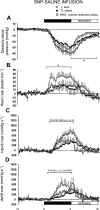Effect of maternal nutrient restriction from early to midgestation on cardiac function and metabolism after adolescent-onset obesity
- PMID: 19244582
- PMCID: PMC2674931
- DOI: 10.1152/ajpregu.91019.2008
Effect of maternal nutrient restriction from early to midgestation on cardiac function and metabolism after adolescent-onset obesity
Abstract
Maternal nutrient restriction (NR) from early to midgestation has marked effects on endocrine sensitivity and organ function of the resulting offspring. We hypothesized that early NR may reset the expression profile of genes central to myocardial energy metabolism, influencing ectopic lipid deposition and cardiac function in the obese adult offspring. NR offspring were exposed to an "obesogenic" environment, and their cardiac function and molecular indexes of myocardial energy metabolism were assessed to explore the hypothesis that an obese individual's risk of heart disease may be modified after maternal NR. Pregnant sheep were fed 100% (control) or 50% (NR) energy requirement from days 30 to 80 of gestation and 100% energy requirement thereafter. At weaning, offspring were exposed to an obesogenic environment or remained lean. At approximately 1 yr of age, the hemodynamic response of these offspring to hypotension, together with left ventricular expression profiles of fatty acid-binding protein 3 (FABP3), peroxisome proliferator-activated receptor-gamma (PPARgamma) and its coactivator (PGC)-1alpha, acetyl-CoA carboxylase (ACC), AMP-activated protein kinase (AMPK)-alpha(2), and voltage-dependent anion channel 1 (VDAC1), was determined. Obesity produced left ventricular hypertrophy in all animals, with increased ectopic (myocardial) lipid in NR offspring. Obesity per se significantly reduced myocardial transcript expression of PGC-1alpha, AMPKalpha(2), VDAC1, and ACC and increased expression of PPARgamma and FABP3. However, although NR animals were similarly obese, their transcript expression of ACC, PPARgamma, and FABP3 was similar to that of lean animals, indicating altered cardiac energy metabolism. Indeed, blunted tachycardia and an amplified inotropic response to hypotension characterized cardiac function in obese NR offspring. The results suggest that maternal NR during early organogenesis can precipitate an altered myocardial response to hypotension and increased myocardial lipid deposition in the adult offspring after adolescent-onset obesity, potentially rendering these individuals more at risk of early heart failure as they age.
Figures






Similar articles
-
Suboptimal maternal nutrition, during early fetal liver development, promotes lipid accumulation in the liver of obese offspring.Reproduction. 2011 Jan;141(1):119-26. doi: 10.1530/REP-10-0325. Epub 2010 Nov 2. Reproduction. 2011. PMID: 21045167 Free PMC article.
-
Maternal nutrient restriction between early and midgestation and its impact upon appetite regulation after juvenile obesity.Endocrinology. 2009 Feb;150(2):634-41. doi: 10.1210/en.2008-0542. Epub 2008 Sep 25. Endocrinology. 2009. PMID: 18818297 Free PMC article.
-
Maternal obesity causes fetal cardiac hypertrophy and alters adult offspring myocardial metabolism in mice.J Physiol. 2022 Jul;600(13):3169-3191. doi: 10.1113/JP282462. Epub 2022 May 11. J Physiol. 2022. PMID: 35545608
-
An overview of the crosstalk between inflammatory processes and metabolic dysregulation during diabetic cardiomyopathy.Int J Cardiol. 2013 Oct 9;168(4):3160-72. doi: 10.1016/j.ijcard.2013.07.150. Epub 2013 Aug 6. Int J Cardiol. 2013. PMID: 23932046 Review.
-
Timing of nutrient restriction and programming of fetal adipose tissue development.Proc Nutr Soc. 2004 Aug;63(3):397-403. doi: 10.1079/pns2004366. Proc Nutr Soc. 2004. PMID: 15373949 Review.
Cited by
-
Berberine elevates cardiolipin in heart of offspring from mouse dams with high fat diet-induced gestational diabetes mellitus.Sci Rep. 2021 Aug 4;11(1):15770. doi: 10.1038/s41598-021-95353-4. Sci Rep. 2021. PMID: 34349203 Free PMC article.
-
Suboptimal maternal nutrition, during early fetal liver development, promotes lipid accumulation in the liver of obese offspring.Reproduction. 2011 Jan;141(1):119-26. doi: 10.1530/REP-10-0325. Epub 2010 Nov 2. Reproduction. 2011. PMID: 21045167 Free PMC article.
-
In utero programming of later adiposity: the role of fetal growth restriction.J Pregnancy. 2012;2012:134758. doi: 10.1155/2012/134758. Epub 2012 Nov 1. J Pregnancy. 2012. PMID: 23251802 Free PMC article. Review.
-
Nutritional programming of the metabolic syndrome.Nat Rev Endocrinol. 2009 Nov;5(11):604-10. doi: 10.1038/nrendo.2009.195. Epub 2009 Sep 29. Nat Rev Endocrinol. 2009. PMID: 19786987 Review.
-
Sex-dimorphic acceleration of pericardial, subcutaneous, and plasma lipid increase in offspring of poorly nourished baboons.Int J Obes (Lond). 2018 Jun;42(5):1092-1096. doi: 10.1038/s41366-018-0008-2. Epub 2018 Jan 30. Int J Obes (Lond). 2018. PMID: 29463919 Free PMC article.
References
-
- Alvarez GE, Beske SD, Ballard TP, Davy KP. Sympathetic neural activation in visceral obesity. Circulation 106: 2533–2536, 2002. - PubMed
-
- Arany Z, Lebrasseur N, Morris C, Smith E, Yang W, Ma Y, Chin S, Spiegelman BM. The transcriptional coactivator PGC-1β drives the formation of oxidative type IIX fibers in skeletal muscle. Cell Metab 5: 35–46, 2007. - PubMed
-
- Banerjee S, Peterson LR. Myocardial metabolism and cardiac performance in obesity and insulin resistance. Curr Cardiol Rep 9: 143–149, 2007. - PubMed
Publication types
MeSH terms
Substances
Grants and funding
LinkOut - more resources
Full Text Sources
Medical
Miscellaneous

